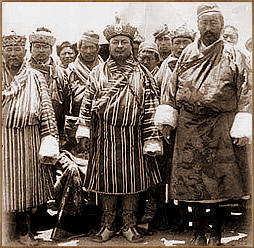| The Monarchy of Bhutan |
| The Kings of Bhutan |
 |
The Wangchuck Dynasty: The 4th King |
|
 |
The Wangchuck Dynasty: The King |
|
|
 |
|
The
First King and the Second King of Bhutan
|
 |
King
Jigme Singye Wangchuck is known to be a spiritual person and a strong
patron of the nation's religious heritage. He has protected and developed
the existing religious institutions and established several new ones. As
a family man with deep-rooted filial attachment he is an example of strong
family values, especially to the youth of Bhutan.
The
First and Second King of Bhutan
 |
Ugyen
Wangchuck
at
the conclusion of Younghusband mission in Lhasa, 1904
To
his left: His cousin and father-in-law Kunzang Thinley.
(Photo:
Johnston and Hoffman, British Library ; The Raven Crown by Michael Aries)
A
new era in the Bhutanese history began on the 17th December 1907, when
Trongsa Penlop (the Governor of Trongsa) Ugyen Wangchuck was elected
as the first hereditary king of Bhutan. It was a decision taken unanimously
by the clergy, officials, and people acting on their desire for political
stability and internal peace in the country. Thus, King Ugyen Wangchuck
laid the foundation for the emergence of modern Bhutan, uniting it under
a central authority. |
The
nation continued to enjoy peace and stability under the reign of the second
king who succeeded him in 1926 and ruled the country till 1952.
 The
Third King - His Majesty Jigme Dorji Wangchuck The
Third King - His Majesty Jigme Dorji Wangchuck
|
 |
After
his ascension to the throne in 1952, the third king Jigme Dorji Wangchuck took the initiative of developing political consciousness among the Bhutanese
people by giving them a greater say in running the country. This was most
evident in the establishment if the National Assembly by the king in 1953,
and later still, when his majesty voluntarily surrendered the right to
veto bills in the Assembly.
King Jigme Dorji Wangchuck also proposed a
mechanism of no-confidence vote that could require the king to abdicate
his throne if he was deemed unfit to rule the nation. This, however, was
met with a great deal of objection and resistance in the Assembly. Upon
yet another recommendation on this issue from the king in 1969, the Assembly
reluctantly approved the resolution whereby the reigning monarch would
have to abdicate if two-thirds of the Assembly supported a vote of no-confidence.
This system was however, abolished by the Assembly during the spring session
in 1973.
Under the third king's reign, the Royal Advisory Council, the
Council of Ministers and Cabinet, and a High Court were also established.
Pertinently known as the father of modern Bhutan, king Jigme Dorji Wangchuck
was responsible for bringing planned development into the country with
the introduction of Five-Year Plans, shedding off centuries old isolation
and opening Bhutan up to the rest of the world. In 1971, Bhutan joined
the United Nations organisation.
| Information on Bhutan |
 |
|



